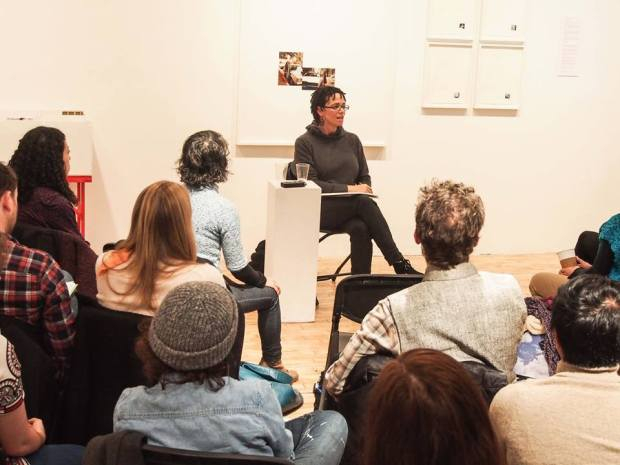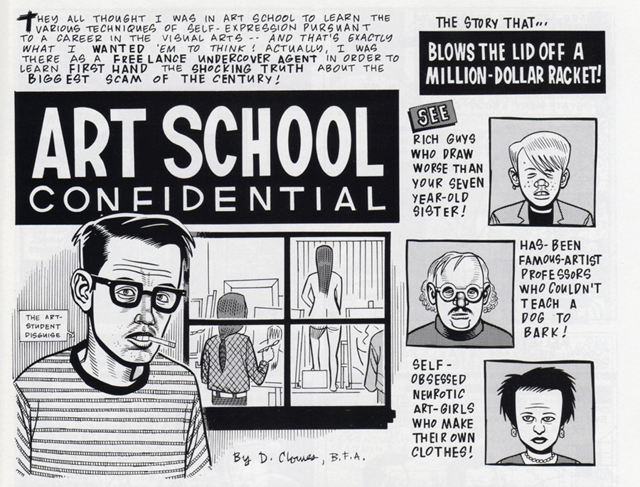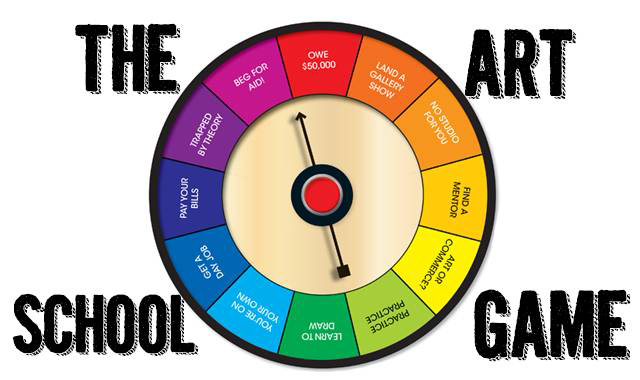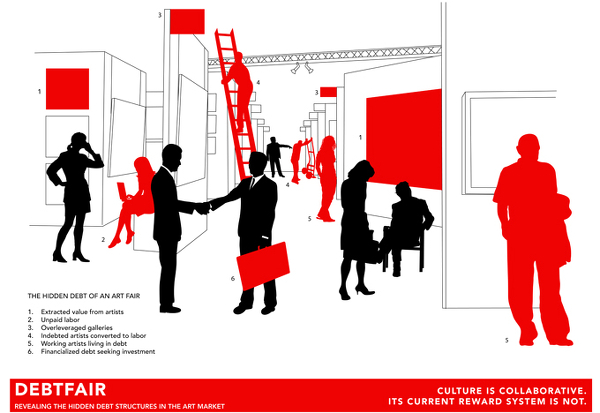Art School Confidential
Creative Extraction: Why Are Art Schools at the Vanguard of Unreasonable Debt Burdens?
Friday, December 5, 2014
Momenta Art and Occupy Museums, Brooklyn, NY
In March 2014, the economics journalist Catherine Rampell crunched numbers from an online US Department of Education tool that collected data on college costs. Her results were stunning. After “subtracting the average amount of government and institutional grant/scholarship aid” for private four-year nonprofit colleges and universities, she determined that “seven of the top 10 most expensive schools are art schools or conservatories of some kind.”1 These included the familiar institutions: the School of the Art Institute of Chicago, California Institute of the Arts (CalArts), and the San Francisco Art Institute. What’s more, two others on her list—the New School and New York University—offer numerous degrees in the arts.2 Tuition and required fees for the top ten range from $36,032 to $42,882 a year—which doesn’t include room, board, and related nonacademic expenses. Keep in mind that these are undergraduate degrees—master’s and doctoral degrees run even higher.
It’s no secret that the tuition for all kinds of schools has increased significantly over the last thirty years, and thousands of students take out huge government and private loans to cover their educational expenses. Those armed with BFAs are unlikely to make tons of money right out of the starting gate, as the familiar narrative goes. Yet we live in a time in which euphoric articles pronounce the MFA as the new MBA appear with alarming regularity.3 What should a young artist do?

Coco Fusco finds art-school debt to be unreasonable (photograph by Tal Beery)
Neither alleviating nor preventing student debt was the subject of an informal, passionate lecture by Coco Fusco, an interdisciplinary artist, writer, performer, and visiting associate professor in comparative media studies and writing for 2014–15 at the Massachusetts Institute of Technology. Speaking from her perch in the academic ivory tower, Fusco vented about the debt crisis, pointed fingers at numerous culprits, and found many sympathetic listeners. (She was a professor at Columbia University from 2001 to 2008—spending five years in the School of the Arts’ renowned MFA program—and following that was director of intermedia initiatives at Parsons the New School for Design from 2008 to 2013). Fusco was a “lone wolf in the wilderness” while teaching at Columbia during the boom Bush years, said Noah Fischer, a former student of hers and a founder of Occupy Museums, the group that sponsored her lecture and was participating in Momenta Art’s exhibition Work It Out.
A year has passed since Modern Painters published Fusco’s essay “Debating an MFA? The Lowdown on Art School Risks and Returns” in its December 2013 issue. For the article Fusco gathered anecdotal knowledge from conversations with students, arguing that debt influences the kind of art a person makes after graduation, that schools use recruiters, and that art theory influences students, for better or worse. While “Debating an MFA?” focused on expensive graduate programs, tonight’s forty-five-minute talk made few distinctions between bachelor’s and master’s degrees and interchangeably addressed art schools, liberal-arts colleges, and research universities. As a result, the targets of her accusations were confused, perhaps deliberately so for rhetorical effect, leaving me without a solid grasp of the problem. It felt like the mark in Three Card Monte.
Cost of the Ticket
The “cost of the ticket” for art school has risen significantly, Fusco said. The 1980s, when she earned her BA and MA, were different. “It’s not that we didn’t borrow money,” she explained. “We didn’t have to borrow as much.” Fusco ended up with “relatively little debt” from her undergraduate education and none for graduate school.4 Back then “school wasn’t the problem—school was the escape,” especially for those riding out tough economic times. Waitressing lunch shifts for four hours a day after first finishing school, Fusco said she was poor but had time for art, and even worked for other artists for free. Needless to say, few can afford this lifestyle today, at least not in New York.
Design schools such as Savannah College of Art and Design and the School of the Art Institute of Chicago figure disproportionately among the institutions that use “predatory lending schemes,” Fusco declared, and the top debtor schools are for-profit institutions. Schools that teach software and web design are “massive factories with debt schemes built into them,” she remarked, and the situation has become intolerable and oppressive. Her information was confusing, since she didn’t explain what these schemes are. Besides, for-profit institutions such as the nationwide chain of Art Institutes or places like Full Sail University teach marketable skills in lucrative creative areas such as web development, video games, and film production.5 Their graduates are hardly knocking on the doors of Chelsea galleries. Fusco left me wanting to know how SCAD and SAIC, which are nonprofit institutions, compare to the for-profits.
In Fusco’s experience, students are battling their parents over money for a collegiate art-school education, and parents are selling property, taking a second mortgage on their homes, and draining their retirement funds to pay for it all. At the same time, schools offer country-club experiences, with lavish dormitories and student centers—not to mention new buildings by starchitects like Thom Mayne and Frank Gehry—to supposedly impress wealthy parents to fork over cash. Paying for such expansions, Fusco said, is higher tuition.

The opening scene of Daniel Clowes’s exposé, Art School Confidential, based on his experiences at Pratt Institute in the 1980s (artwork © Daniel Clowes)
During the first audience Q&A, an older man recommended that artists “show up” and “be weird.” Why even go to art school, he asked, suggesting that we get rid of the middleman and hook up students with working artists through apprenticeships. “That’s the medieval way,” Fusco responded, which “can become free labor for a long time.” Another attendee, the writer Corinna Kirsch of Art F City, wanted to know how we might let parents know about debt in advance. I asked Fusco if she knew how much effort today’s students make to find nonloan funding for their education? What about student complacency regarding tuition increases, questioned another person. Fusco did not have adequate answers. We are at a point when the outrage is over, Fusco had said earlier, and organizing should begin. But the only solution she offered was going to free schools like the Bruce High Quality Foundation University and “others in Los Angeles,” as if these groups offer something comparable to a degree from an accredited institution. It’s disappointing if Bruce High Quality is the only alternative pedagogical project that she knows by name. Fusco can find a rich history of both current and discontinued alternative pedagogical institutions indexed by the TEACHABLE FILE and use Google to discover newer projects making headlines.6
Proliferation of Degrees
The proliferation of degrees at art schools isn’t an expansion of choices, Fusco argued, but an opportunity for schools to procure more students and dispense degrees without providing marketable skills (e.g., fabrication, installation, canvas stretching, and finding your way around a woodshop). Indeed, any subscriber to the Art and Education email list can vouch for the mushrooming of art-degree programs in discourse-based areas such as, for example, the MA in art, education, and community practice at New York University, the MA in social design at Maryland Institute College of Art, or the MA in social documentation at the University of California, Santa Cruz.7 Talkers who don’t make things don’t last long, Fusco warned, even though she acknowledged that she’s a talker artist herself.
It’s more expensive for a school to maintain a glassblowing or ceramics studio, Fusco said, than to provide space for students doing social practice and, in her words, “transdisciplinary design.” While I generally agree with Fusco—it seems likely that programs for socially engaged art, which have multiplied in recent years as the genre gained visibility and respect, are less expensive to operate than programs in studio art—I can’t help but think that academic institutions are places where significant changes in how artists interact with the world take place. While initially frivolous sounding, these new degrees may evolve into progressive incubators for careers that haven’t yet grown mainstream roots. On the other hand, is a $50,000 to $100,000 investment in an experimental, emerging field worth the risk?
Art School Administration
Fusco stated that art schools increasingly operate in a corporate manner, a glib remark evoking the evil ways of vulgar capitalism. Yet pundits have proposed the same thing for ALL of higher education for years, if not decades, and the tedious concept of university-as-business becomes superfluous when considering that any institution that ignores balancing income and expenses will simply not survive. Continuing her blanket dismissals, Fusco claimed that art schools confuse students by promoting themselves as research centers for knowledge production, when in fact these institutions are trade schools focused on technical training. (Didn’t she say earlier that students aren’t being taught usable skills?) “There is no concept of research in trade school,” Fuso said, apparently comparing studying art to vocational training in refrigeration or plumbing. Her line of thought might have served a purpose if she had identified the BFA or the MFA as her target, or even specified the culprits of her critique.

Image illustrating “Debating an MFA? The Lowdown on Art School Risks and Returns,” Coco Fusco’s article from Modern Painters
Art schools devise ways to make the precarious employment of teachers permanent, Fusco continued, saying “It’s way beyond adjuncts now.” In fact, she stated that 90 percent of faculty members at art schools are adjuncts, without providing a source for this figure. “Those contracts have wonderful names,” she joked, “like visiting professor, visiting associate adjunct whatever, the titles go on and on, but the bottom line is that this is about the permanence of impermanence.” Adjunctification is indeed a huge problem across academia and especially in the visual arts. The three art capitals of America—New York, Chicago, and Los Angeles—boast a larger supply of artists, Fusco reported, and therefore teaching is a rough way for them to make a living. She floated the idea of living and working in Kansas City or Iowa City, in Dallas or Houston, but didn’t seem to take that seriously.
A decline in full-time professors, Fusco went on, has adversely affected faculty governance. In addition to being poorly paid, she said, adjuncts lack a political voice within the institution and must placate students and not rock the boat—“it’s about hanging on.” Professional development has also suffered, which has led to teachers using thirty-five-year-old syllabi. “No one should be allowed to do that,” she fumed. Artists are the hardest adjuncts hit, since part-timers in design and architecture usually have day jobs, which affects their political outlook on precarious labor. “They don’t want more obligations,” Fusco said, so it’s hard to win their support for change. Art schools, she told us, employ students in positions where other institutions, such as MIT, have a support staff of unionized professionals. While a federally subsidized work/study program is certainly beneficial for students, I can imagine that not having properly trained people running the darkroom or the print shop to be frustrating.
Because art schools face a dearth of applications from the US and a high turnover of students after one year, Fusco claimed, schools don’t have enough students—that is to say, they don’t have enough students to justify the expense of the legions of administrators who manage the pupils. Therefore an influx of foreigners has populated programs at Pratt Institute, the School of Visual Arts, and CalArts. “Where am I, in Singapore?” she joked at the sea of yellow faces in art schools today. That comment sounded xenophobic, if not racist.
Seductions Strategies and Art Market Collusion
The seduction strategies that recruit students are real, Fusco said, and people aren’t told the truth before entering school—which is that most artists will not make it. (Who are these recruiters?) The lure for the Columbia MFA program in recent years, she said, is that an unidentified department head told students in private conversations that they’ll be rich before they finish school or they’ll hang out with famous art-world people who will help them find money. Fusco also argued that glamorous precarious workers—described by the journalist Riva Seth as “highly educated, skilled professionals who frequently are well compensated but nonetheless lack the security, social benefits or established career trajectories traditionally associated with their professions”—have an illusion of independence.8 Yet the media spin on successful young artists, she warned, fails to acknowledge that artworks bought by collectors who speculate are typically priced less than $10,000 each—hardly a get-rick-quick scheme. Of course, during her talk Fusco assumed—almost arrogantly so—that market success in the commercial art world is the solitary goal of those attending MFA programs. Throughout her talk she avoided discussing any other reason why artists might better themselves through education, leaving no room for other career pursuits.
During the 1970s, Fusco revealed, artists didn’t depend on the market: selling art was unusual and artists found cheap ways to live. Now those artists—whom she identified as male Conceptual artists teaching in higher education—aren’t the ones who can spread an awareness to students of the need for immediate financial returns after graduation. I’m not sure how that observation squares with her other comments. For example, Fusco said that some professor-artists connect their students to the market because that’s all they can offer as teachers. Art dealers visited CalArts in the 1980s to meet the students of Douglas Huebler and John Baldessari, the “spiritual children of the Svengali types” as she put it. And during the 1990s, Fusco continued, dealers visited students at the University of California, San Diego, and Yale University School of Art. It was certainly revealing that, according to the speaker’s anecdotes, the art market had begun invading MFA programs over thirty years ago, that it’s not surprising for gallery owners and collectors to pluck fresh talent from artists still in training.
If a young artist’s goal is to exhibit at galleries like Murray Guy or Reena Spaulings Fine Art, Fusco said, or to show in a booth at a New Art Dealers Alliance art fair, then he or she should consider attending expensive graduate schools. At Columbia, she disclosed, students specialize in networking, socializing, and drinking—and even complained to administrators when Fusco made them read and write. “Those students are like little barracudas,” she groused. “If they could kill me and get to my dealer, they would.”
Since “you’re paying $50,000 a year to be looked at before you even begin your career,” as Fusco claimed, should a prospective student attend a top art school or settle for an MFA program in the hinterlands of America, where he or she might earn a full ride? In the age of $120,000 art degrees, to borrow a slogan from the collective BFAMFAPHD, the latter option is the only sensible choice. Fusco named Arizona State University in Tempe and Carnegie Mellon University in Pittsburgh as possibilities. For an artist interested in technology, she suggested heading to a school with the latest equipment, like Rensselaer Polytechnic Institute, and not to a boutique MFA program that specializes in seminars. I’ve heard that the University of California in Irvine and in Riverside, the University of Florida in Gainesville, and Southern Illinois University in Carbondale all offer generous packages to MFA students. Germany just made higher education free for anyone, Fusco pointed out, and students don’t even have to be citizens. If it’s actually true that “students who go to high-profile schools get a subtle eighteen-month bump after they graduate,” as the critic and adjunct professor Jerry Saltz wrote, then attending a less-prestigious and less-expensive school—and consequently incurring little if any debt—before moving to New York (or wherever) to break into the commercial gallery scene makes a lot of sense.9 This artist will have hundreds of extra dollars a month for studio rent, art supplies, and food.
During the audience Q&A, the artist Kenneth Pietrobono, who like Noah Fischer is involved in Occupy Museums, declared that he turned down a spot in an MFA program at New York University because the cost of attending was too high, despite loan money being available. That was a wise decision. When faced with rising costs for art school and low expectations after graduation, prospective students must recognize that they are adults who are capable of conducting research, seeking counseling, and making their own decisions before accepting tens of thousands of dollars in loan money. They also must recognize the importance of saying no to unfavorable financial situations. But the fact remains that many artists have shackled themselves with huge amounts of debt, and that is a pity.
In Terms Of count: 3.
1 Catherine Rampell, “The Most Expensive Colleges in the Country Are Art Schools, Not Ivies,” Washington Post, March 28, 2014.
2 The tenth institution, Beacon College, is a small school in Florida “exclusively serving students with learning disabilities, ADHD, and other learning differences,” according to its homepage.
3 See Steven Tepper, “Is an MFA the New MBA?,” Fast Company, March 23, 2013; Glenn Schaeffer, “Why the MFA Is the New MBA,” Vegas Seven, May 20, 2010; Katharine Bell, “The MFA Is the New MBA,” Harvard Business Review, April 14, 2008; Janet Rae-Dupree, “Let Computers Compute. It’s the Age of the Right Brain,” New York Times, April 6, 2008; Ronald Jones, “The Art Market,” Frieze 101 (September 2006). The concept of MFA=MBA was developed by the business writer and theorist Daniel H. Pink in his Free Agent Nation: The Future of Working for Yourself (New York: Warner Books, 2002) and popularized in the February 2004 issue of the Harvard Business Review.
4 Fusco earned a BA in semiotics from Brown University (1982), an MA in modern thought and literature from Stanford University (1985), and a PhD in art and visual culture from Middlesex University (2005).
5 The Art Institutes, for-profit schools owned by Education Management Corp that teach media and commercial art, not the fine art of painting and sculpture, have had their own legal problems. See David Halperin, “EDMC Professors and Students Speak: How Lobbyists and Goldman Sachs Ruined For-Profit Education,” Republic Report, September 24, 2012; and Chris Kirkham, “With Goldman’s Foray into Higher Education, a Predatory Pursuit of Students and Revenues,” Huffington Post, October 14, 2011.
6 See Maggie Gray, “Creative Schools: The Artists Taking Art Education into Their Own Hands,” Apollo, September 10, 2014; and Ryan Gander, “Ryan Gander’s Plans for an Art School in Suffolk,” Apollo, September 10, 2014. These kinds of conversations and projects, however, have been taking place for years, if not decades.
7 It’s interesting that all three are MAs, not MFAs. Because these are not terminal degrees, their recipients will not be qualified to teach art at the college or university level.
8 Riva Seth, “Give Precarious Workers a Chance,” Policy Options (September 2014).
9 Jerry Saltz, “An M.F.A. Degree Is Too Expensive, and That’s Only the Start of the Problem,” Vulture, December 5, 2013.
Read
Corinna Kirsch, “No Remedies: Coco Fusco on the Ills of Art School,” Art F City, December 18, 2014.



